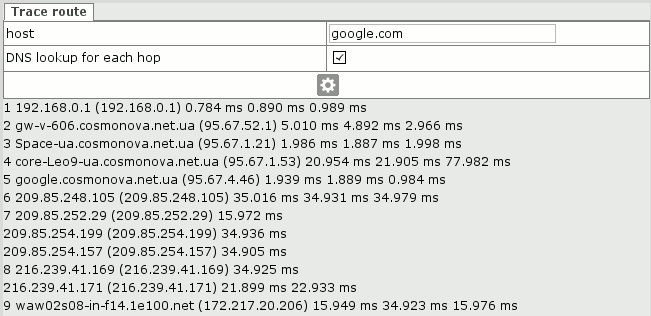Trace route¶
In computing, traceroute is a computer network diagnostic tool for displaying the route (path) and measuring transit delays of packets across an Internet Protocol (IP) network.
The history of the route is recorded as the round-trip times of the packets received from each successive host (remote node) in the route (path); the sum of the mean times in each hop is a measure of the total time spent to establish the connection.
Traceroute proceeds unless all (three) sent packets are lost more than twice, then the connection is lost and the route cannot be evaluated.
Ping, on the other hand, only computes the final round-trip times from the destination point.
Traceroute by default sends a sequence of User Datagram Protocol (UDP) packets addressed to a destination host; ICMP Echo Request or TCP SYN packets can also be used.
The time-to-live (TTL) value, also known as hop limit, is used in determining the intermediate routers being traversed towards the destination. Routers decrement TTL values of packets by one when routing and discard packets whose TTL value has reached zero, returning the ICMP error message ICMP Time Exceeded.
Traceroute works by sending packets with gradually increasing TTL value, starting with TTL value of one.
The first router receives the packet, decrements the TTL value and drops the packet because it then has TTL value zero.
The router sends an ICMP Time Exceeded message back to the source.
The next set of packets are given a TTL value of two, so the first router forwards the packets, but the second router drops them and replies with ICMP Time Exceeded.
Proceeding in this way, traceroute uses the returned ICMP Time Exceeded messages to build a list of routers that packets traverse, until the destination is reached and returns an ICMP Echo Reply message.
The timestamp values returned for each router along the path are the delay (latency) values, typically measured in milliseconds for each packet.
The sender expects a reply within a specified number of seconds.
If a packet is not acknowledged within the expected interval, an asterisk is displayed.
The Internet Protocol does not require packets to take the same route towards a particular destination, thus hosts listed might be hosts that other packets have traversed.
If the host at hop #N does not reply, the hop is skipped in the output.
Traceroute employs User Datagram Protocol (UDP) datagrams by default, with destination port numbers ranging from 33434 to 33534.
The traceroute utility usually has an option to instead use ICMP Echo Request (type 8) packets, or to use TCP SYN packets.
Example of traceroute output:
